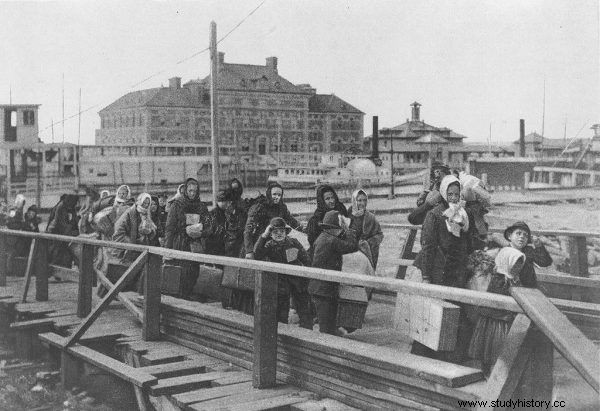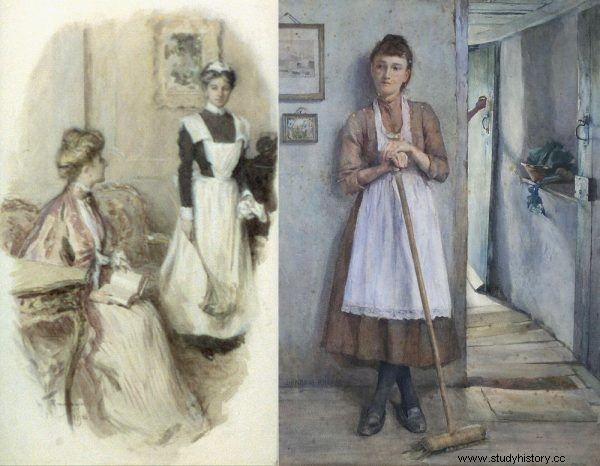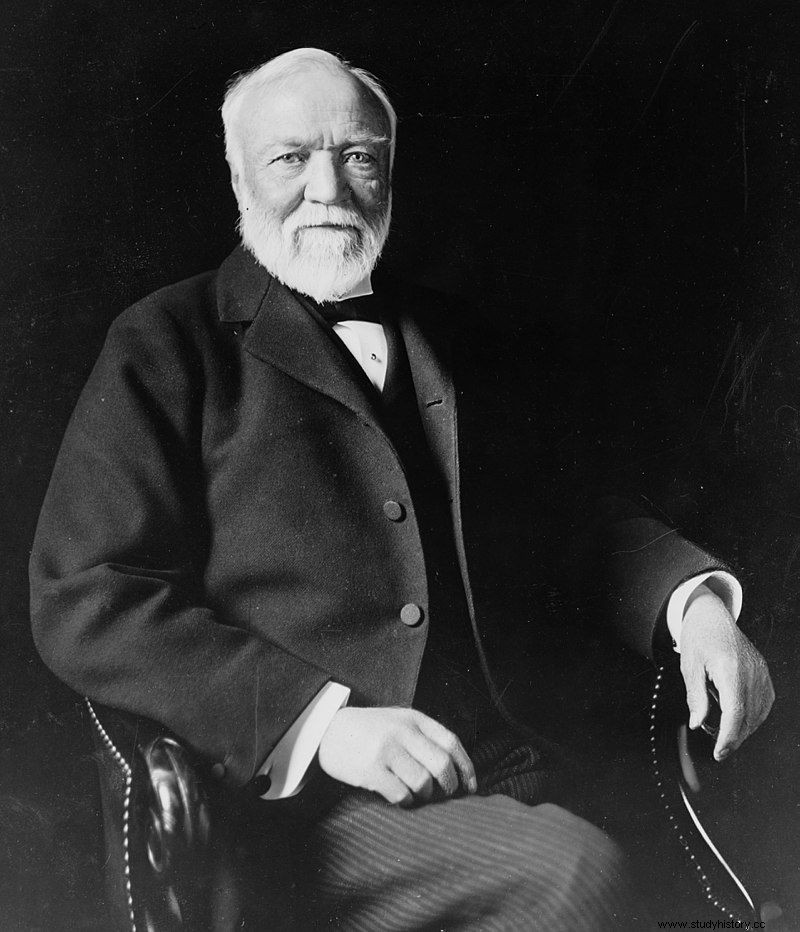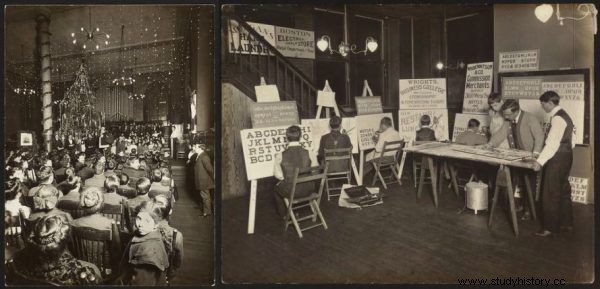Young girls went to the USA, the land of dreams and dreams of a great career, in hope for a better future. They ended up being maids - "slaves", treated worse than animals ...
For centuries, high-born ladies employed servants for mundane household tasks such as cooking, washing and cleaning. While the aristocrats maintained numerous servants, the newly emerging strata of wealthy burghers and entrepreneurs were initially satisfied with only a few peaceful ones. As we read in the study on domestic help in the Edwardian era (after Queen Victoria's death) Life Below Stairs by Alison Maloney:
In the pre-war years, the family's social status largely depended on the number of servants employed. It was an obvious indicator of wealth. Many richer families employed up to twenty servants, and in noble families the servants often numbered thirty or forty people. Over three hundred people served at the Duke of Westminster's country residence, Eaton Hall in Cheshire, although such a large number was an exception even among the aristocracy. .
The nouveau riche often employed one domestic help for a whole range of duties. As emphasized in the article Domestic Revolution Theresa McBride, the maid "took over some or all of the duties of the wives." Of course, they had to be available at the request of the state.
Aaaa… I will be hired from Ireland
The nascent United States adopted the social and family customs of the English. After the abolition of slavery, there was a huge increase in the popularity of the profession of a maid to help the housewife in her daily duties. They employed poor, young immigrant women for whom low-paid, near-slave service was a struggle to make ends meet and the only chance to support their family.

The nineteenth-century United States went through a period known as the Reconstruction after the end of the Civil War. They were slowly becoming the world's greatest industrial power. No wonder they attracted immigrants on a massive scale. Pictured here is Ellis Island (an island in the port of New York) which has literally been a gateway to millions of immigrants for over 60 years.
The American poet and essayist Ralph Waldo Emerson, in his essay Domestic Life ( Home life ), described the hardships of family maintenance that rest on the shoulders of women:
Housing management is nothing beautiful, it gives no fulfillment to husband, wife, children, hosts or guests. It is a form of women's oppression. It is a job that brings no joy, and the ideal is achievable for few women at a very high cost. .
Emerson emphasized that there would always be a loss in some sphere of life in pursuing this ideal. He wrote that it is not possible to take care of children at the same time, order at home and punctual meals without sacrificing, for example, your social life or your own needs. Ultimately, you can have the perfect home, but with properly trained service:
Either the master and the mistress of the house devote themselves to running the household at the expense of their own achievements and development, or achieve this goal by treating other people objectively .
The treatment in question was met mainly by domestic maids. As successive waves of immigrants from Europe reached the shores of the United States, young girls were told that their best occupation would be to serve in wealthy homes, thanks to which they would become polished and assimilated the values of American society, such as discipline above all.

The richer American society, despite the abolition of slavery, did not abandon the treatment of service as an object. Maids were one of the most severely treated (compared to all domestic help) by their principals. Pictured on the left is a painting by William Thomas Smedley from 1906, on the right - Henry Meynell Rheam.
Their principals often became obsessed with overseeing their private lives, imposing certain dress codes, or restricting contacts with other young people. In this way, immigrant women fell into a vicious cycle of professional and social isolation:they did not have time to socialize or learn new skills, which would allow them to find a better job in the future. And while other occupations changed over the years, the servants were looking forward to providing the eight-hour working day or the minimum wage for a long time.
Poverty with poverty
Although in American society in the second half of the nineteenth century as many as half of the working women were employed as maids or laundresses, at the beginning of the new century only 1/3 were engaged in this faculty. It was not at all the peak of dreams of poor girls and women, who often could not even count on decent living conditions. Christine Stansell, in her book City of Women:Sex and Class in New York, 1789–1860 (The City of Women:Gender and Social Class in New York, 1789-1860), describes the living conditions of a servant who lived in the attic, stuffy, cold, using old, decaying furniture .
Girls were often denied access to basic amenities such as a toilet or bathtub. They had to use potty pits or out-of-door privates, and bathe in the kitchen - of course, after bringing water from the well. In 1912, an anonymous letter from a woman who had worked as a maid for over 30 years and decided to share her experiences appeared in The Outlook magazine. A rather gloomy picture emerges from it:
If there is an old rocking chair in the house that is no longer suitable for home use, they will put it in the maid's room. Usually many rooms in the house are well heated, but in the maid's room it is so cold that it is impossible to sew or read. (...) The housewives often feed their dogs and cats with meat in the dining room. For a girl who has to eat in the kitchen, it is no longer enough .

Andrew Carnegie was an American industrialist of Scottish descent. He often donated his enormous wealth to the creation of cultural and scientific institutions. However, even philanthropy did not protect his factories from strikes fighting for decent wages and working conditions.
In a very similar way, she portrays the everyday life of her heroine, Marie Benedict, in the novel Billionaire's Maid , inspired by real events. . A young Irish woman, working in the Carnegie family of steel magnates, describes her enormous responsibilities towards the lady of the house:
I have mastered the endless cycle of cleaning her combs and brushes, removing stains from dirty clothes, starching muslins, washing the bowls, glasses and jugs used in her personal rooms. I followed a strict plan, remembering about fresh water, flowers, towels, ironed sheets in the bathroom and bedroom, assessing the condition of her underwear, darning stockings, sewing sheets and brushing dresses. I had even become Mrs. Carnegie's competent companion in the formal social gatherings that filled her days. I used to go with her for morning visits to friends and for tea in the late afternoon .
A holiday for the service? Never wait!
The light in the tunnel appeared in the 20th century. The struggle began to professionalize the profession, hence the emergence of home help training facilities, such as the School of Housekeeping in Boston, where you could learn to care for hygiene and order at home, food chemistry and financial management. In New York, Children's Aid Society has launched training courses for girls who want to learn sewing, cooking and cleaning. The biggest problem, however, was the relationship with the lady of the house, which - to put it mildly - was far from ideal.
The Legal Aid Society of New York and the Boston's Domestic Reform League fought to establish contracts between hired girls and their housewives. In 1915, the Homework Employment Commission of YWCA USA (Young Christian Women Association) was established, which issued a bulletin on the treatment of girls employed in these occupations. "Systematization of household tasks, strict definition of working hours, allowing female employees a sufficient amount of free time and personal freedom to lead a normal life among their relatives" - these are just some of the many demands of the association.
From servant to employee
Soon after the end of World War I, American society went into prosperity , better working conditions and the improvement of the professional situation of women. The war, however, slowed the influx of immigrants, reducing the number of women willing to work hard in the homes of wealthy Americans.

Children's Aid Society was a private non-profit charity based in New York City. Founded in 1853, it educated both girls and boys. Apart from adoption care, she also provided training programs towards specific professions.
Between 1899 and 1920, the percentage of women working in this way fell by half and stood at around 16%. In the next decade, perhaps due to the crisis, this percentage rose to 20%. Women and girls employed as maids usually spent at least two hours longer at work than their female colleagues in other professions. Many of them worked hard all week. The worst situation was for those who lived with their employers and were practically dependent on them .
It was only with the introduction of daily wages that the working and living conditions of the former domestic service improved, resulting in a change of the servant-housewife relationship to the employee-employer relationship. Shorter time spent at the workplace contributed to the autonomy and professionalization of the profession. Domestic helpers, nannies and maids gained an advantage in negotiations and could build modern relationships, leading to the shaping of a modern model of work in these professions.
***
The extraordinary story of a young and ambitious immigrant who came to 19th-century America in search of a better life was presented by Marie Benedict in her latest novel, The Billionaire's Maid. Clara Kelley of the richest man's maid in the US, Andrew Carnegie, becomes his secret advisor over time.
